Text
17th Century Shell Guard Broadsword


There's something unique about holding a piece of history that dates back four hundred years. They have a presence, a gravitas that, more recent swords lack.
So, what is this sword? The Royal Armouries simply describes the examples in their collection as an early 17th-century broadsword with shell guard (Object IX.172). While Ewart Oakeshott in his book "European Weapons and Armour - From the Renaissance to the Industrial Revolution" describes two types of swords with related characteristics: the German sabre, circa 1540s, with forward and rear quillons, a knuckle bow, and a distinctive shell guard covering the outside of the hand. Plus, the second type of Sinclair hilt, with its one-piece S-shaped crossguard forming the rear quillon and knuckle guard.



At the same time, the Dutch sword historian J.P. Puype describes these as a Solingen horseman's sword of the classical type: "The problem with this type of sword is that so far there has never been written a proper monography on them and that opinions on them are practically always unsubstantiated by evidence. The other problem is that they are often seen as naval but there is more evidence to tell us that they were army swords.
I think that I may be the first arms historian who identified these swords as cavalry swords, but I have to admit that in publications prior to 1998 I (too) identified them exclusively as shipboard cutlasses.
In the 1990s I became increasingly involved in writing publications and doing museum exhibitions on Prince Maurice and the new Dutch so-called States Army of the 1590s. In the course of this involvement I analysed the pictures by Jacob de Gheyn made during the 1590s of the infantry drill and cavalry drills. These infantry pictures were published in a book in 1607, although we know that its manuscript was already in existence c. 1595-c.1597, but was withheld by Prince Maurice for reasons of security.
Simultaneously, a book on the cavalry exercise was conceived, but its publication was permanently withheld by Maurice, partly for security reasons, partly also because Prince Maurice in 1597 or 1598 abolished the lancers.
Among the cavalry prints the heavy cavalry has as its chief weapon the lance (it was abolished in 1597 or 1598 in favor of the wheel-lock pistol, and the lancers became 'pistoliers'). However, the light cavalry is armed with swords with shell-guard hilts.


So we can only prove that the seashell-hilted sword apparently originated in the cavalry. The earliest proof that I have of its maritime use is after 1700. I do not know how to explain the picture of the French privateer Lolonois of 1684 (the year of appearance of the original Dutch edition) who is armed with a seashell-hilted cutlass with a curved blade with clipped point.

One other of the very few other 17th C pictures I know in which appear what seem to be shell-hilted cutlasses is on the title-page of a book published in 1673 (see the attachment). There is a heap of apparently seashell-hilted cutlasses in the foreground but it is clear that the hilts are rendered in a wrong version. The blades, however, are curved and with clipped point.

In or before 1978 the wreck of a flatboat was found in the lake what once was the Zuyderzee. This boat was full of arms and military equipment, destined for what were army outposts on islands against a possible French invasion in 1672. Among the cargo were four swords with seashell guards and straight blades. In the attachment are two archaeological drawings.


All this does not bring us definitive answers to the problem when we view the portrait of the French privateer l'Olonnais (spelled as Lolonois) in which he is holding a seashell-hilted cutlass with curved blade with clipped point. I do not know of the actual existence of such a sword - nowhere in the world. I dare not go so far as to suggest that swords of this type may be artists' impressions only but somehow it does feel that way!"
Jan Piet Puype.
In short, these are another variation of military broadsword that would have been common amongst the military armies of the first half of the 17th-century. While it is appealing to look at the portrait of the French privateer Lolonois as evidence that these swords have a naval connection, the unfortunate reality is that the artist likely never met his subject. Furthermore, he made a notable error in the sword's detailing; with the quillon and knucklebow reversed, the sword becomes impractical to wield. In conclusion, we see an artist's impression, not a historical representation.
In German and Dutch references, these swords are called houdegen or houwdegen, which translates to 'hewing sword'. Although short, their weight and broad, double-edged lenticular blades give these swords a no-nonsense functionality. A single fuller runs for the first 20% starting at the guard. The ricasso is a square block with two smaller side fullers running along its length. On both sides of the ricasso is a maker mark of a crown above an O and T. According to the Royal Armouries, this is the mark of a Spanish smith. However, I have seen one text attribute this to a Solingen swordsmith. Given that the blade has ME FECIT and SOLINGEN (Solingen Made Me) stamped into the fuller, it seems more likely that the stamp is either a copy of the Spanish maker mark or one unique to a Solingen blade maker.



The grip retains its' original wire and Turks head knots at each end. It has a pear-shaped pommel with a tang button on the top for the peen. Although I can't be sure, I expect the pommel is hollow, like we see on the Amsterdam Walloon swords.
The S-shaped crossguard and shell guard are two separate pieces that appear to have been forge-welded together. While the hilt and pommel on my sword are solid, the guard is loose. There probably used to be a fabric or leather washer between the blade shoulder and guard to hold them tight. On the inside of the guard, it continues to cover the thumb, curling around on itself to form a thumb ring. This combination of knuckle bow and shell guard offers the wielder a lot of hand protection.


Stats: Overall Length - 870 mm Blade Length - 725 mm Point of Balance - 90 mm Grip Length - 140 mm Inside Grip Length - 80 mm Weight - 900 grams
#antiques#swords#military antiques#light cavalry#17th century#80 years war#30 years war#shot and pike
127 notes
·
View notes
Text


Early 17th Century Swept Hilt Rapier
I've had this sword for a couple of months, but I've been slow to post it while learning more about it. When I started out collecting, there were always a couple of dream swords that I'd love to own. On the top of that list were the schiavona and the swept-hilted rapier.
For the most part, rapiers have been out of reach for me. Decent swept hilts command significant money while determining their authenticity is a further challenge that adds unwanted risk. Fortunately, I found a sword within my fiscal comfort zone and quirky enough to attract my attention.
The genesis of rapiers first appeared in 15th Century Spain as a distinctly civilian sword. The progressively improved hand protection resulted in swords equally good in the defence as the offence. This allowed the users to forgo armour and earned these weapons the name espada roperas, 'swords of the robe'. As their use spread, the name mutated. They became known as la rapiere in France and rapier in England.
As so often happens, the term rapier came to encompass a wide selection of swords with various blade profiles. Broadly speaking, rapier describes a large civilian sword for dismounted combat with a complex hilt that offers significant hand protection and a thrust-centric blade. The latter is essential because complex hilts weren't limited to just rapiers; they were mounted on other blades more suited to cutting than thrust-based fencing. As Ewart Oakshott writes, "If you can cut off a man's arm with it, then it's a sword, if not a rapier."
However, as the use of armour declined in the 17th Century, its use peaked, with rapiers making their way onto the battlefield during the latter stages of the Eighty Years' War, where the Dutch fought for independence from Spain; the Thirty Years' War in Germany, and the English Civil War.
By the end of the 17th Century, a new, smaller rapier with its' own form of fencing began to appear in France. It was significantly shorter and lighter than what came before, with an even more specialised thrusting blade. This sword became known as the smallsword and persisted until the end of the 18th Century as the gentleman's sidearm to defend self and honour.


This recent addition to my collection is not an extravagant sword; in fact, it can be better described as 'munitions grade'. The hilt and blade are very functional, robust, and devoid of the decorations and markings usually seen on higher-grade rapiers. It is the type of sword that a musketeer might have worn in the service of one of the many pike and shot armies that fought in the wars that plagued Europe in this era.


Using the A. V. Normans' typology, my rapier has a Type 58 swept hilt and a Type 30 inner guard. According to A. V. Norman, this hilt type appeared around 1560 and remained until about 1635, although my sword likely dates to between 1600 and 1630.
This rapier is a shockingly large weapon. On paper, one and a quarter metres is just a number without real context. But when you stand it against your side and realise it nearly comes up to your chest, it takes on a whole new meaning. The sword is also heavy, a fraction heavier than my French AN XI Curassier swords, which up until now had been my heaviest swords by a good margin.
The sword is in excellent condition, without significant corrosion or other signs of neglect. Only the grip wire is a recent replacement but nicely done in the style of the time, with a Turk's head knot at both ends.


Stats: Overall Length - 1,245 mm Blade Length - 1,070 mm Point of Balance - 75 mm Grip Length - 153 mm Inside Grip Length - 100 mm Weight - 1,340 grams
#swords#antiques#military antiques#17th century#30 Years War#80 Years War#Rapier#Swept hilt#Cut and thrust
77 notes
·
View notes
Video
youtube
NZAHAA Annual Arms Fair - 2024
3 notes
·
View notes
Text

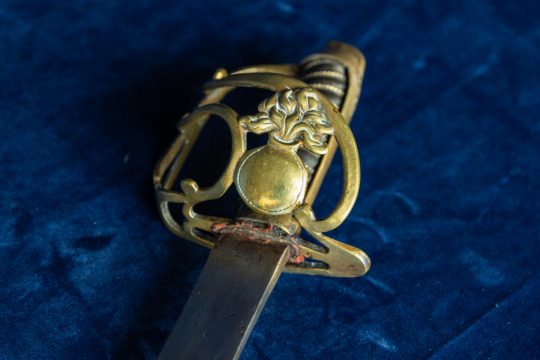
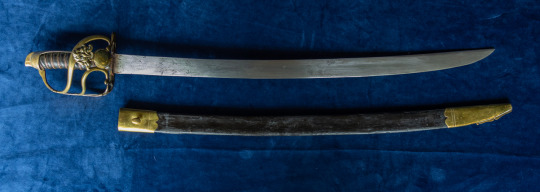
French Grenadier Officers' Sabre - Petite Montmorency style. Circa 1788 - 1800.
The social upheaval in France during the late 18th century was pervasive through all levels of society. People were abandoning the old and adopting a number of new styles and fashions to display their allegiance to which ever faction the belonged to; the (soon to be executed) king, the revolution, or some variation of the politics at the time.
One of these changes in fashion began around 1784 with infantry officers giving up their model 1767 smallsword in favour of non-regulation sabres, often based on the styles copied from the cavalry. The rotating guard hilts were one such example.
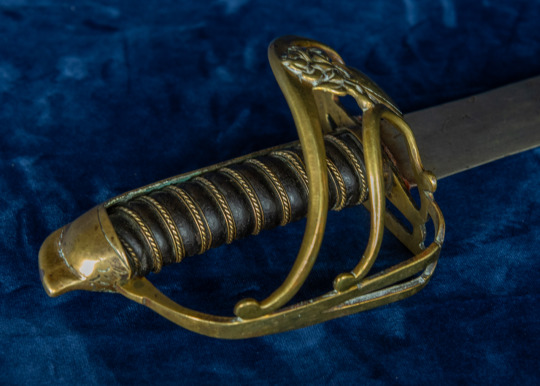
With the Royal decree of April 1788 permitting the use of sabres by the infantry we see another type appear, swords with slotted hilts and sidebars that often feature military emblems such as the light infantry hunters horn or the grenadiers flaming bomb. While others (normally associated with the National Guard) display elaborate political symbolism like Roosters or lions with the Phrygian cap; icons of bravery, the French State and the revolution.
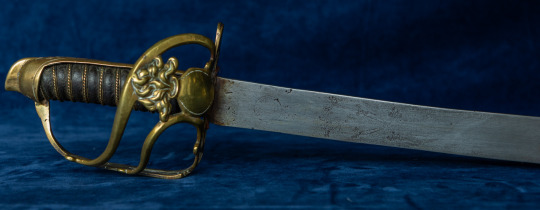
Because these sabres were non-regulation, they don't follow a set pattern; and can be plain or very ornate. Seeking to classify them, collectors of the late 19th Century noted that many swords in this style had blades that matched the profile of the Montmorency Dragoons; a curved blade with a central fuller and a secondary fuller running close to the spine.
Since they were carried by infantry or National Guard officers, on the whole this style of sabre are shorter than the dragoon type, thus earning them the petite montmorency moniker. As with many such arbitrary names, its meaning has expanded in use to cover a wider group of swords that are broadly similar but don't follow exactly the same features. This sword is such an example. The slotted hilt and guard are very typical with the helmet pommel, sidebars and flaming bomb. However because the blade is has no fuller, it can't be said to have a true montmorency blade. Still, it is the best grouping we have for this sword. This sword is a handy weapon, just shy of 80cm long with a 66cm blade. The lack of a fuller means is weighs 750 grams, giving it a lot of presence in the hand. The blade engraved with the word Grenadier on one side and flaming bomb with a trophy and bomb on the other; otherwise it is very plain.
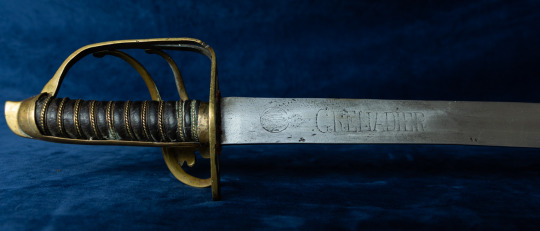
On the spine there is an arrow wrapped in a scroll, which I assume to be related to the maker. I'm sure I've seen this mark before but now I can't find the source. If you know what it means, please let me know.

Stats: Overall Length - 795 mm Blade Length - 655 mm Curve - 15 mm Point of Balance - 140 mm Grip Length - 142 mm Inside Grip Length - 105 mm Weight - 750 grams
#swords#sabres#antique swords#military antiques#napoleonic era#18th Century#French Army#Infantry Officers#Officer Swords#Grenadiers
94 notes
·
View notes
Text
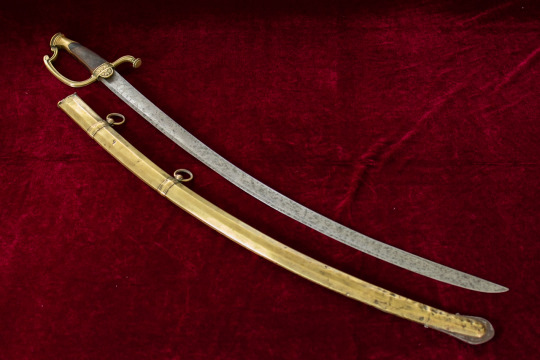
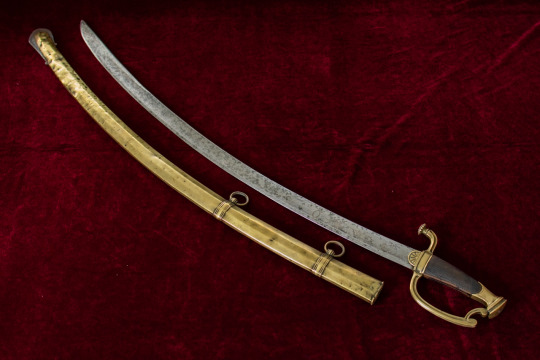
Napoleonic era French light cavalry officers' sabre with the à la Marengo style hilt
This style of sabre hilt, with the rounded langets and semi-S shaped guard. Is one of two types that are associated with the la Marengo type. The other has a similar cross guard but a pommel cap that bends towards the knuckle bow, decorated with a lions' face.
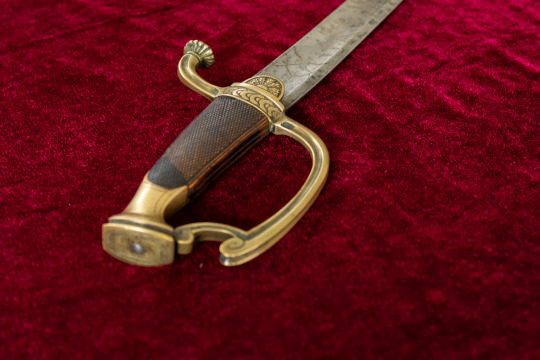

These styles are said to have gained popularity following Consular Napoleon's victory over the Austrians in Jun 1800 at the Battle of Marengo. French sword cutlers purportedly drew their inspiration from the sabre carried by Napoleon during the campaign.
It has been claimed that only officers who had participated in the battle were permitted to carry this style of hilt, however this is unlikely to have been true, given the number of surviving examples.
This sword carries a Solingen made 'export' blade with generic engraving that would originally have been highlighted in gold on a background of blue.
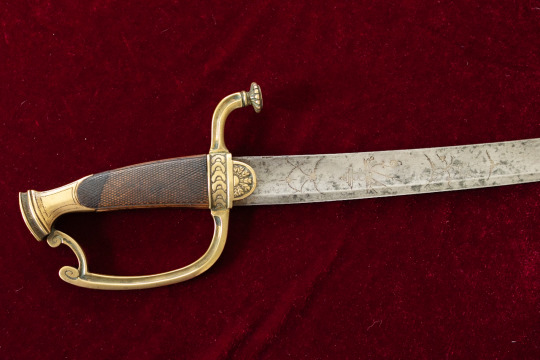
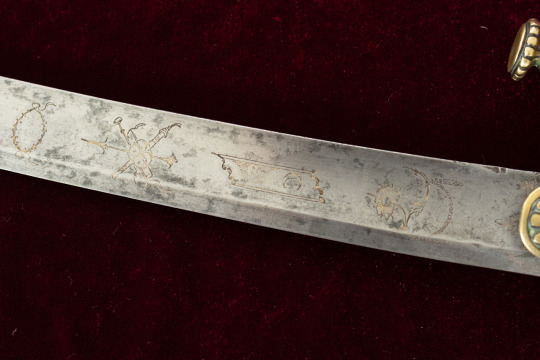
Stats: Overall Length - 935 mm Blade Length - 795 mm Curve - 54 mm Point of Balance - 140 mm Grip Length - 125 mm Inside Grip Length - 105 mm Weight - 700 grams
#swords#sabre#Napoleonic era#military antiques#antiques#sabres#cavalry swords#military#19th Century#Light cavalry#French military
83 notes
·
View notes
Text


French infantry officers 'Sabre à Garde Tournante'
This is my second 'Sabre à Garde Tournante' which translates to sabre with a rotating guard, referring to the unique side bar that folds in front of the knuckle-bow when not in use.

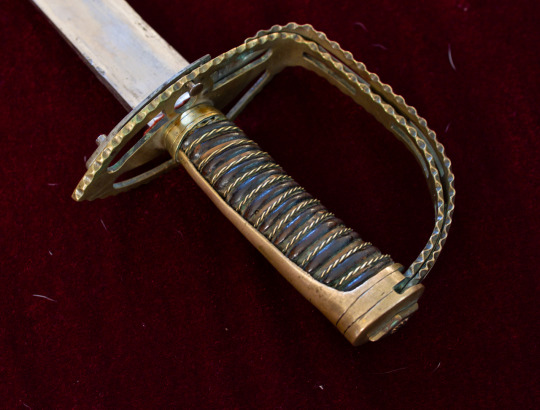
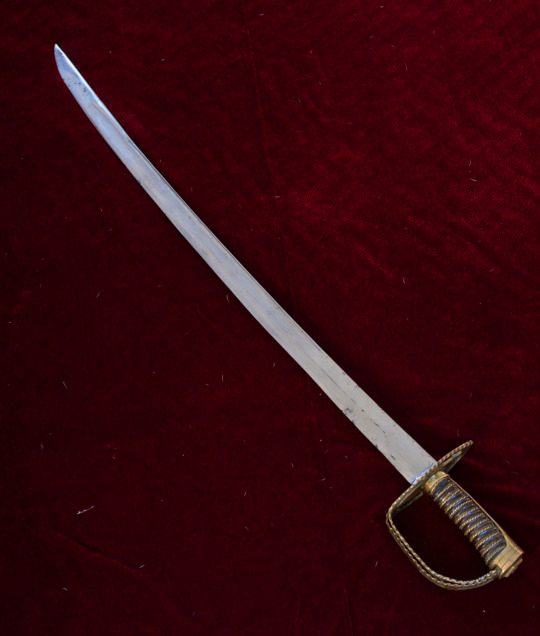
This style of guard became popular in France around 1784 and remained fashionable until about 1800. For a short period the English also followed this trend and they can occassionally be found on 1788 Pattern light cavalry officer swords or 1786 regulation infantry officers swords. But the style faded out with the introduction of the 1796 Patterns. Interestingly Austria actually adopted the rotating guard into their regulation patterns and there it remained in use until the middle of the 19th Century.
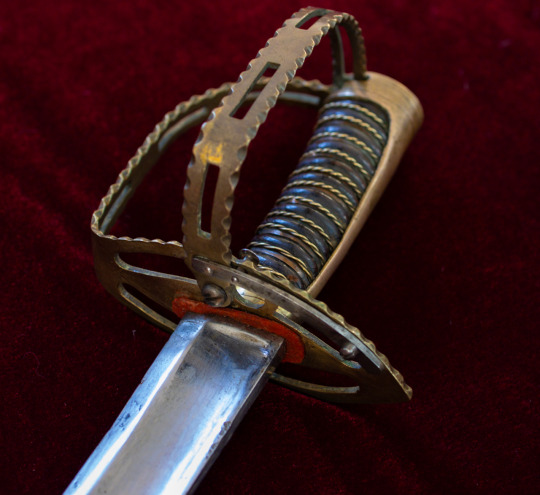
This example has a single side guard that folds out to the outside of the grip that has been scalloped along the edge with a decorative feature that is frequently seen on these swords.

The short blade length and the single frog stud on the scabbard chape mark this as having belonged to an infantry officer of a lower rank who still marched with his men.
Stats: Overall Length - 765 mm Blade Length - 740 mm Curve - 14 mm Point of Balance - 110 mm Grip Length - 125 mm Inside Grip Length - 105 mm Weight - 610 grams
#sword#sabre#rotating guard#French military#antiques#military antiques#18th Century#napoleonic wars#French swords#Sabre a Garde Tournante
45 notes
·
View notes
Text



French 'Sabre a l'Orientale' cavalry officers' sword
The 'Sabre a l'Orientale' (often called mameluke swords in English) gained popularity with fashionable officers during the French campaign in Egypt and Syria (1798 to 1801).
Initially, these swords would have been acquired in battle either as a trophy, from being given as a token of respect by allies, or from a surrendering foe.
However, as the fashion spread throughout Europe, local sword makers and cutlers began to produce their own interpretations of the style, such as the regulation dress sabres of British Lancers.
This sword style remains in service today as the British 1831 Pattern General Officers sword and US Marine Corps Officer dress sword.
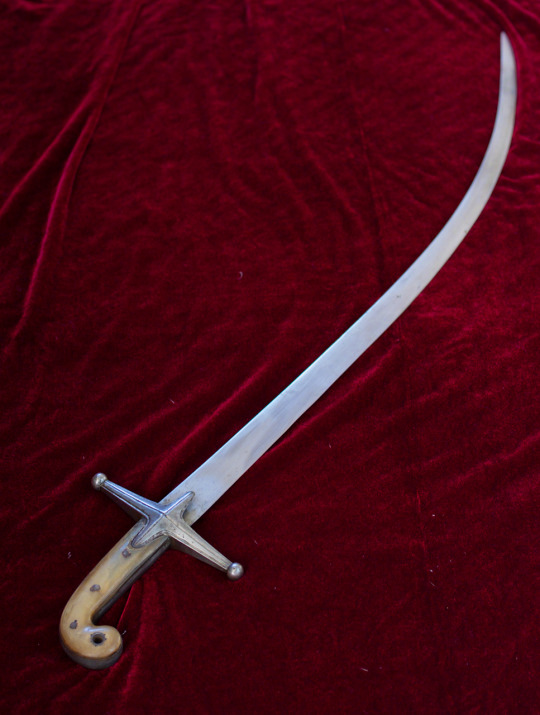

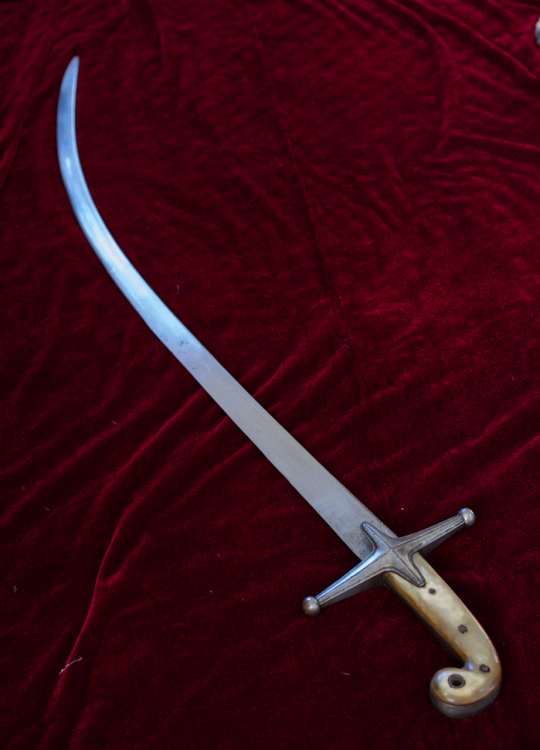
My sword likely dates from 1810 to 1830 and caught my interest because it features an Eastern-produced shamshir blade mounted in a European-made mameluke-style hilt with cow or buffalo horn grip scales. The sword is plain and functional without the ornamentation typically found on swords belonging to senior officers. Going by the style of scabbard drag, this sword originally belonged to a French cavalry officer.
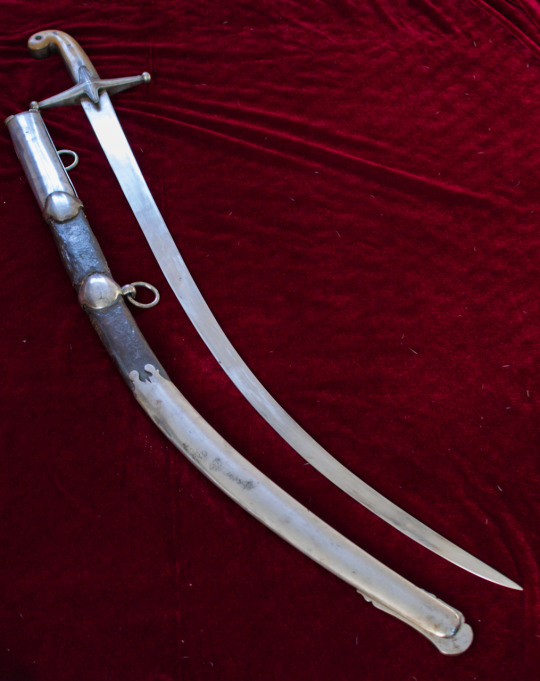
Stats: Overall Length - 950 mm Blade Length - 805 mm Curve - 75 mm Point of Balance - 1730 mm Grip Length - 125 mm Inside Grip Length - 94 mm Weight - 920 grams
#sabre#sword#sabres#swords#antiques#military antiques#French swords#Mameluke#napoleonic wars#mamaluke sabre#Sabre a l'orientale
108 notes
·
View notes
Text
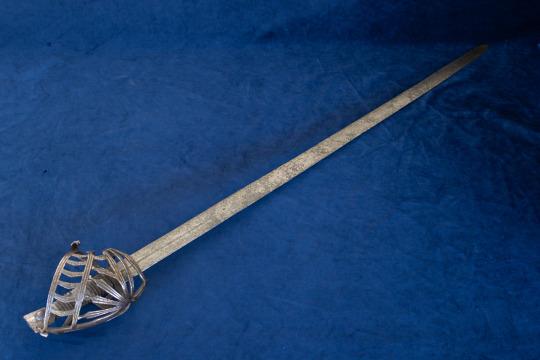
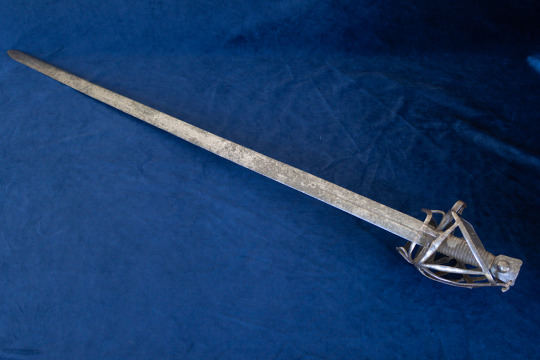
Early 18th Century Venetian 'Schiavona' Sword
The Schiavona is an iconic basket-hilted sword that was closely associated with the Italian city state of Venice. The earliest examples are believed to have come from an elite body of Slavic soldiers hired by the Venetian council, and date back as far as the late 16th Century.
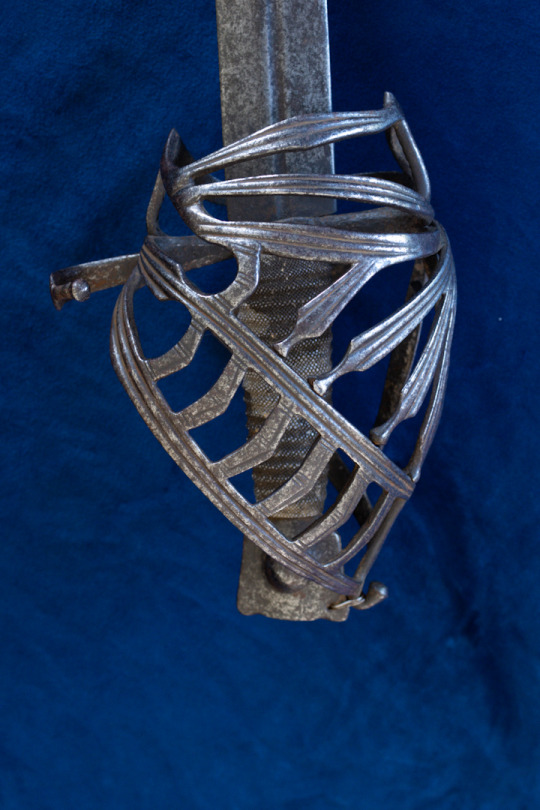
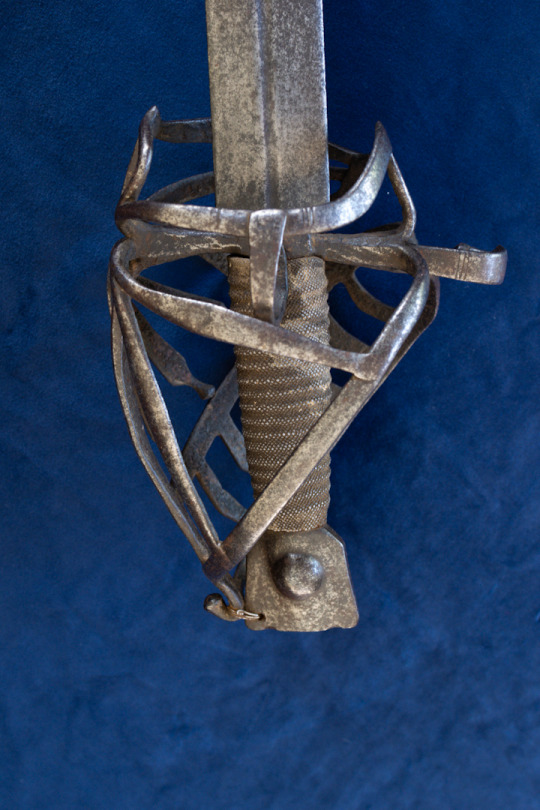
Schiavona are identified by their unique basket hilts and 'cats head' pommels. The renowned sword historian and author, Ewart Oakeshott grouped the schiavona basket hilts into two broad categories, the simplified Type 1 with it's broad flat bars, and the Type 2 of lattice work design.
They Type 1 hilt began to appear around the early 1600's and the first Type 2 between 1620 and 1630. Type 1's remained in use for most of the 17th Century after which Type 2 hilts became dominant.
Over the life of schiavona swords, (1600 - 1797) their hilts became increasingly complex and ornate as they became associated with the character of Venice, with the upper levels of society also carrying their own schiavonas.



Based on the features of the hilt, this sword most likely dates to 1710 - 1740. The iron pommel and 93 cm blade suggest that it is of munitions grade and was likely carried by a regular cavalry man.
Stats: Overall Length - 1,075 mm Blade Length - 930 mm Point of Balance - 165 mm Grip Length - 135 mm Inside Grip Length - 94 mm Weight - 1,090 grams
#swords#antique swords#military antiques#Italian#City of Venice#Cavalry swords#Schiavona#18th Century#Broadsword#basket hilt#Italian Basket Hilt
268 notes
·
View notes
Text

New sword day Always a pleasure to come home to a parcel containing swords. Top to bottom they are: French infantry officers Sabre' à Garde Tournante circa 1780 -1800. British 1796 pattern infantry officers' sword (co-shipped for a friend). French cavalry officers' Sabre à l'Orientale circa 1810 - 1830.
#french swords#swords#sabres#saber#mameluke#Sabre à l'Orientale#Sabre' à Garde Tournante#British Swords#1796 Pattern infantry officers' sword#napoleonic wars#military antiques#antiques
43 notes
·
View notes
Text
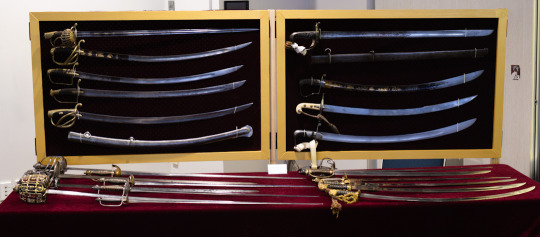
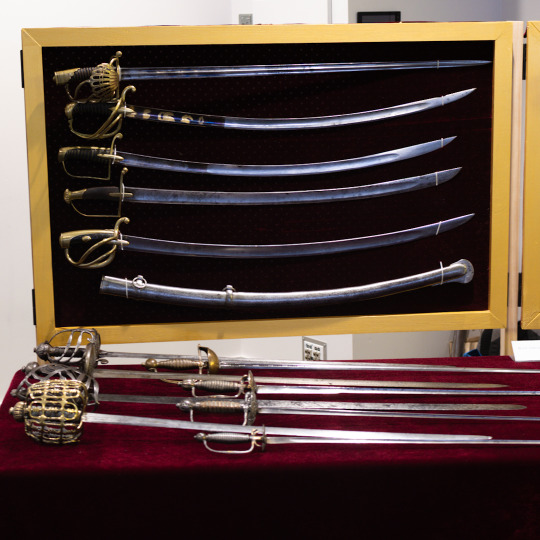
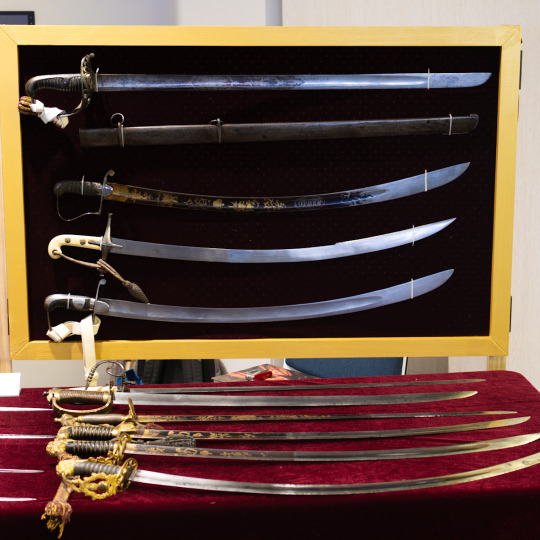
Photos of the sword display I had at last weekends excellent Auckland Blade and Knife show.
Was great to see meet with New Zealand's very talented knife makers showing off their work. Truly inspiring works of art.
For my display I opted to have a selection from the collection that covered a broad range instead of focusing on the one topic.


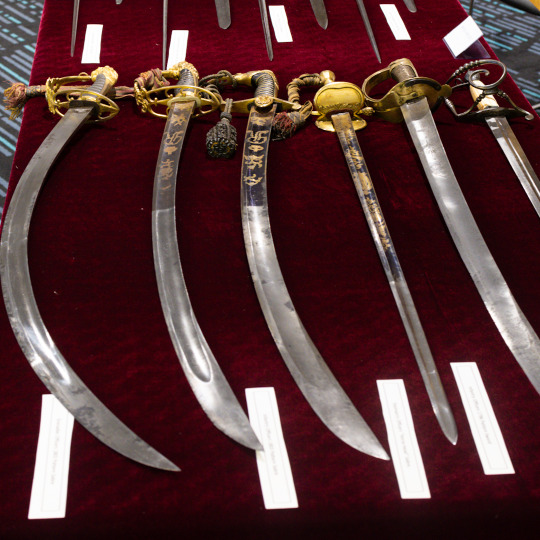
It was also my first use of the new boards I made after the last show. These are on their own stands giving me more table space.
Despite being a bit rough about the edges (remember folks, measure twice, cut once 🤣) they worked well. The next challenge is to improve on how the swords are mounted. Cable ties work great, but they're fiddly to pass through the cloth backing while trying to hold up a sword at the same time.
My thanks to The Auckland Blade Show for organising such a great event and for allowing me to participate. Shows like these are key to showing people just what is available and possible.
#swords#antiques#napoleonic wars#military antiques#british army#sabre#cavalry#Shows#Displays#Walloon Sword#Schiavona#Smallsword#Baskethilt#Spadroon
148 notes
·
View notes
Text
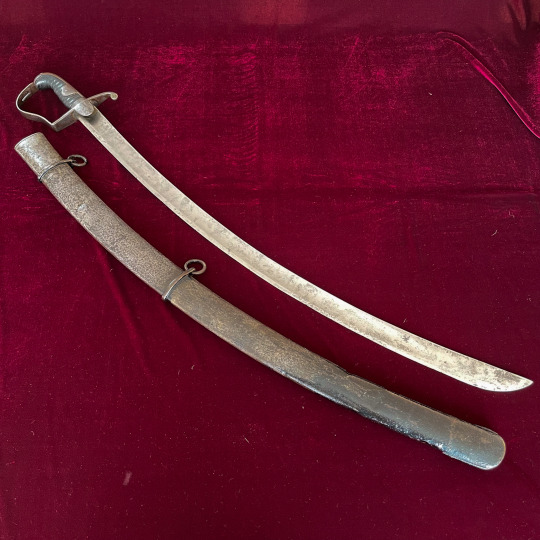
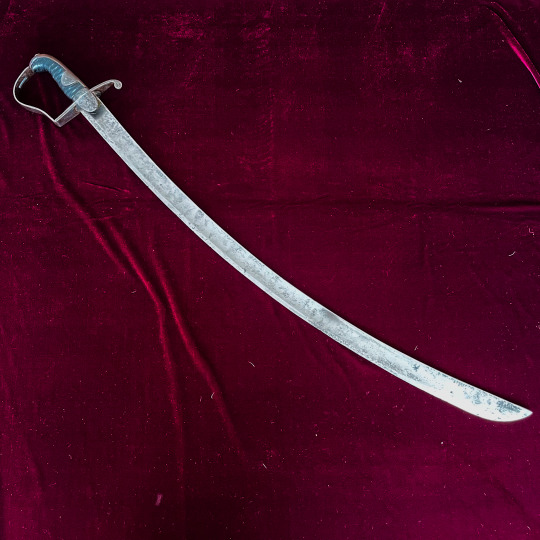
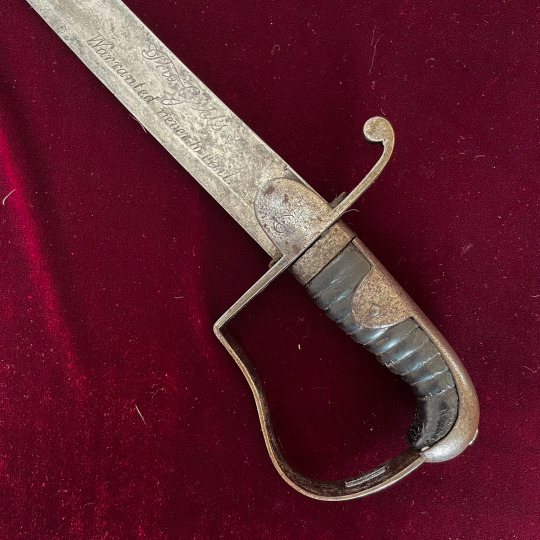
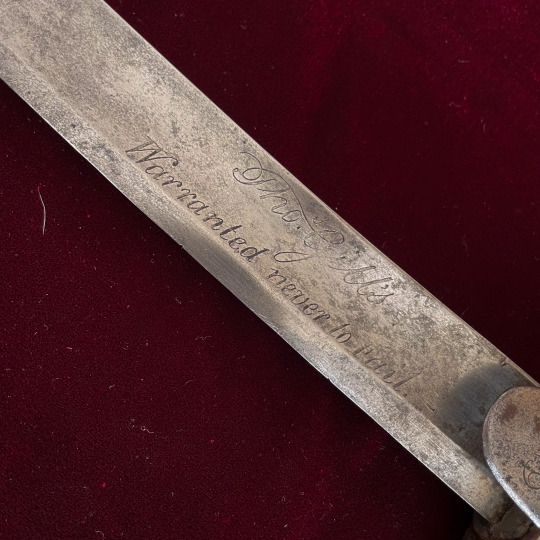
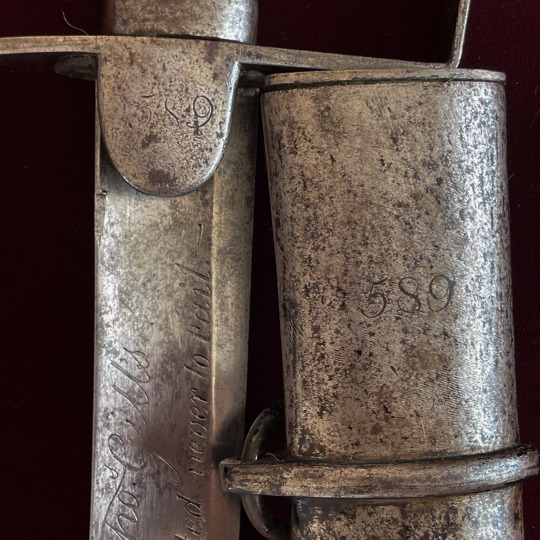
1796 Pattern light cavalry troopers sabre by Thomas Gill, circa 1796 - 1801.
#Sabre#1796 Pattern#1796 Pattern Light Cavalry#British Cavalry#Yeomanry#british army#napoleonic wars#military antiques#swords#antiques#light cavalry#cavalry
124 notes
·
View notes
Text

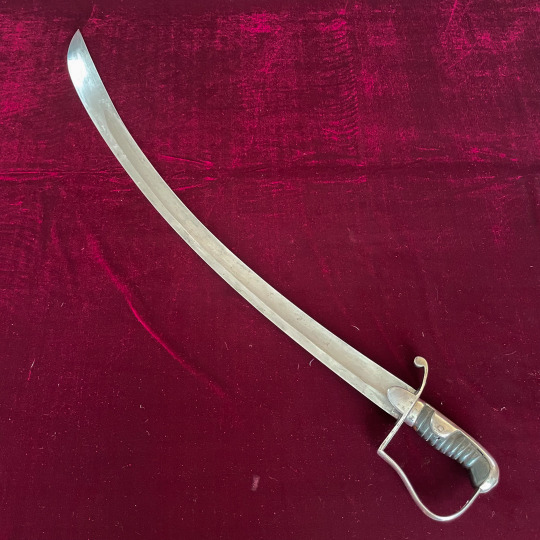
Dutch m1813 No.1 light cavalry troopers sabre.
While initially supplied with English made 1796 Pattern light cavalry sabres in the late months of 1813, the Dutch Army procured a further 3,800 sabres from different Solingen manufacturers between 1814 and 1819.
The m1813 No. had a long service life, being issued to the Light Dragoons, Hussars, Lancers and the East Indian Cavalry. Even when it was replaced in 1829 with the No.3 light cavalry sabre, many were re-issued to the 'Jagers te Paard' and second line units.
They likely remained in service until the late 1830s early '40s when the remaining stocks were inspected and put into storage at the Artillery depot in Brielle. In 1880 hundreds of out of service swords were transferred to the Rijksmuseum and put on display in the Waterloo hall.
While there are visual differences between the Prussian m1811 Blucher sabre, itself a copy of the 1796 Pattern, the Solingen produced m1813 No.1's are visually identical to British made sabres, and can only be identified by their Dutch control stamps and the absence of British ones.
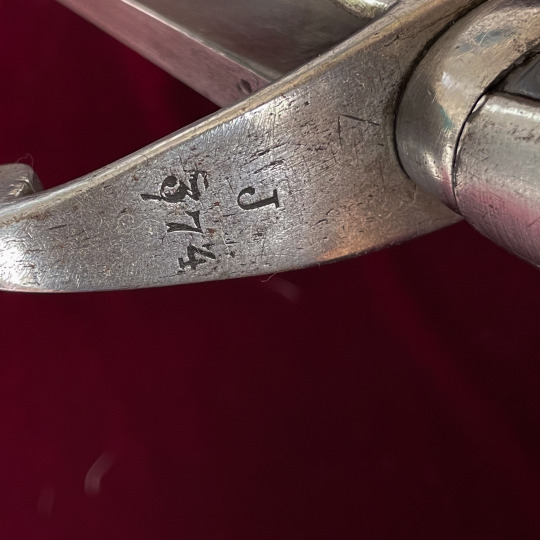

This sabre was one of the swords re-issued to the Jagers te Paard (hunters on horse) as can be seen by the serial number on the quillon which appears to have over-stamped an earlier mark. The blade is dated 1833 on the ricasso and the spine has an *L inspectors stamp, probably belonging to P. Libert who, from 1831 was the controller edged weapons, until retirement in 1840.
This 1833 date likely means that the sabre was given a replacement blade supplied by an arms maker from Liege.

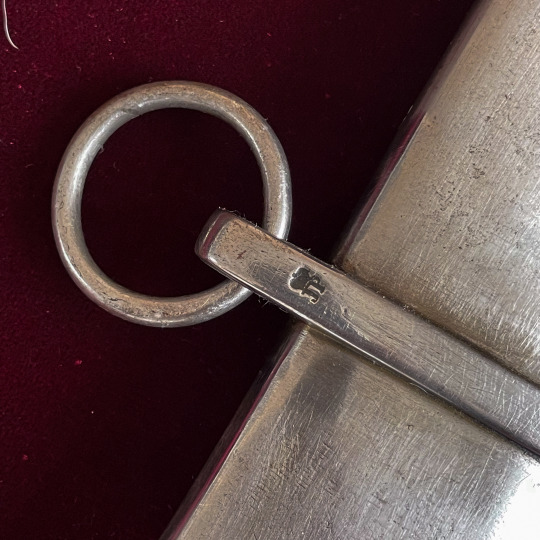
The Crown over V stamp belonged to A van Deventer, who was seconded in Solingen 1837-1839 then stationed at the Inspection HQ in Delft 1843-1845
The Crown over JP stamp is believed to have belonged to the Controller Jean Joseph.
The last two photos show the m1813 No.1 next to a 1796 Pattern LC made by Thomas Gill between 1796 and 1800. The Gill sword was likely a private contract for a Yeomanry troop since there are no ordnance board proof stamps on the blade.
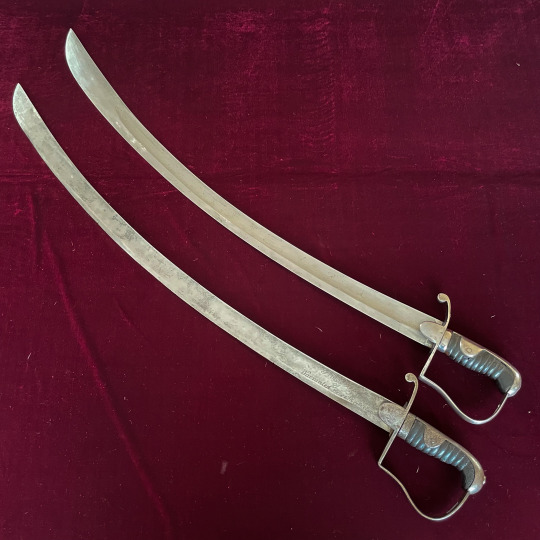

The tip of the m1813 No.1 is noticeably broader than the 1796 Pattern LC. This results in the sword having a 21 cm point of balance vs 16.5 cm on the 1796.
If you look closely at the edge of the 1796, you can see that it is slightly concave. This is evidence of damage in service that has been repaired. The chips that are also visible and commonly seen on other blades are more likely to have been caused by careless owners after they were sold out of service.
#Dutch Army#Cavalry#Light cavalry#m1813 No.1 Sabre#Sword#Sabre#Antique#Military Antiques#napoleonic wars#10 Day War#1796 Pattern Light Cavalry Sword
62 notes
·
View notes
Text
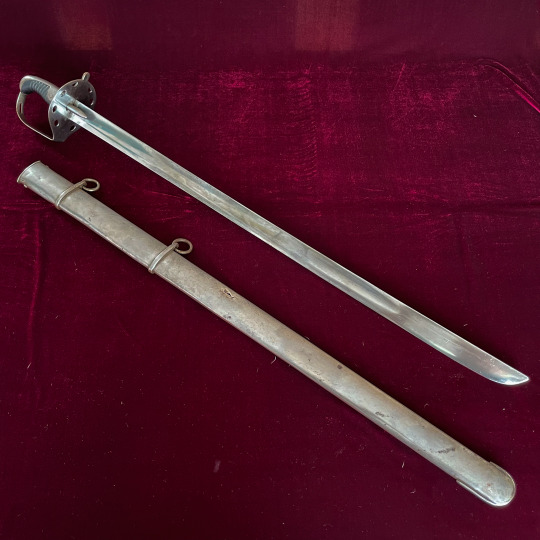
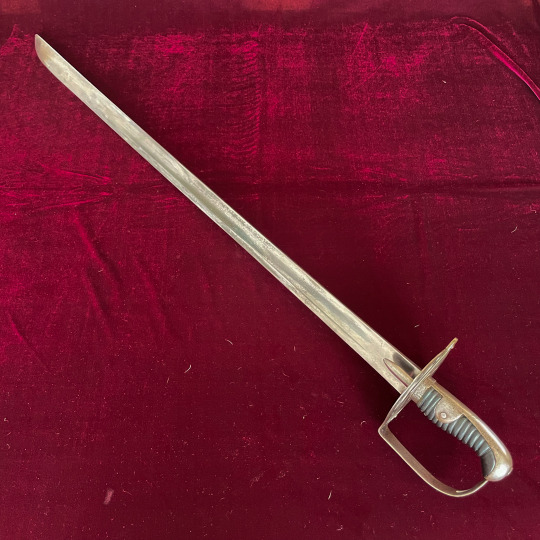
1796 Heavy cavalry troopers sword by Dawes in original configuration (although the grip leather has been replaced).
When Major John Gaspard Le Marchant, proposed his new cavalry sabre design with his system of mounted swordsmanship; his intention was for his new sabre to be the universal sabre for the British cavalry (a concept that was 60 years ahead of it's time).
And while his sword was accepted as the 1796 Pattern light cavalry sabre, the officers of the heavy cavalry insisted on a straight bladed design. Falling back on his experiences with the Austrian cavalry in the Low Countries campaign (1793-95) he suggested a sword that was an almost direct copy of their model 1769 pallasch.



While an effective cutting sword, the hatchet tip of the 1796 HC, was not suitable for thrusting and in service these were often re-profiled to have a spear tip. Other changes included removing the langets and narrowing the guard on the inside to prevent wear on the uniform while wearing.
Like it's light cavalry counterpart, the 1796 Pattern sword was also exported to Britain's allies; Portugal and Sweden during the Napoleonic wars.


#sword#back-sword#pallasch#1796 Pattern#1796 pattern heavy cavalry sword#cavalry#British Army#Georgian Era#Napoleonic wars#military antiques#heavy cavalry#John Gasapard Le Marchant
142 notes
·
View notes
Text
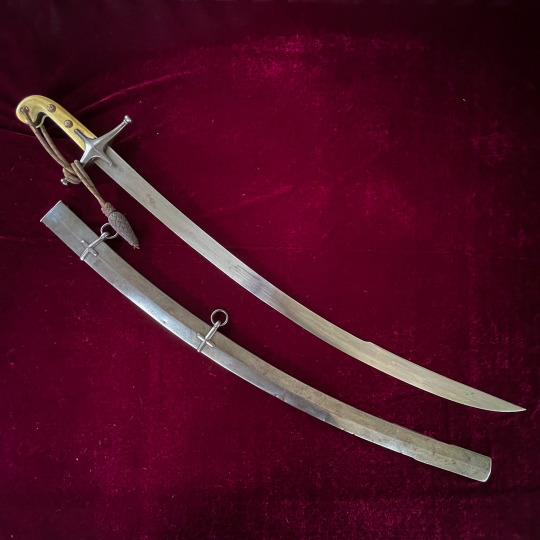

Late Georgian era British Lancers or Dragoon officers dress Mameluke sabre. While they are called 'Mameluke' sabres by collectors, they are in truth a Europeanised interpretation of the shamshir or kilij sabres that the actual Mameluke warriors used. The 'Mameluke' sabre had become fashionable with many British (and French) officers following Napoleon's Egyptian campaign and were carried by many notable officers on both sides of the conflict, including the Duke of Wellington. However, it was only in 1822 that the British army first officially recognised the 'Mameluke' as a regulation pattern for the newly formed lancer regiments. In 1831 with the Pattern sword for General Officers, which remains the current dress sword for Generals in the British and many Commonwealth Armies to this day. Mameluke sabres can also be found with links to other light cavalry and some heavy cavalry regiments, plus they were carried as bandsman's swords.


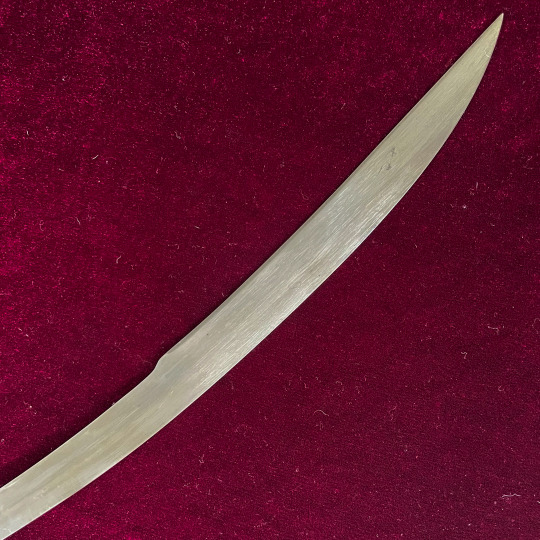
#sword#Sabre#Mameluke#Light Cavalry#Napoleonic Wars#Antiques#Antique Weapons#Military history#British Army#Lancers#Georgian Era#19th Century
107 notes
·
View notes
Text

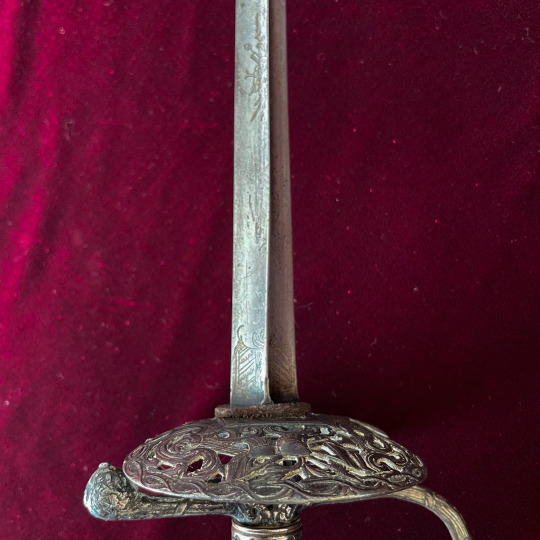
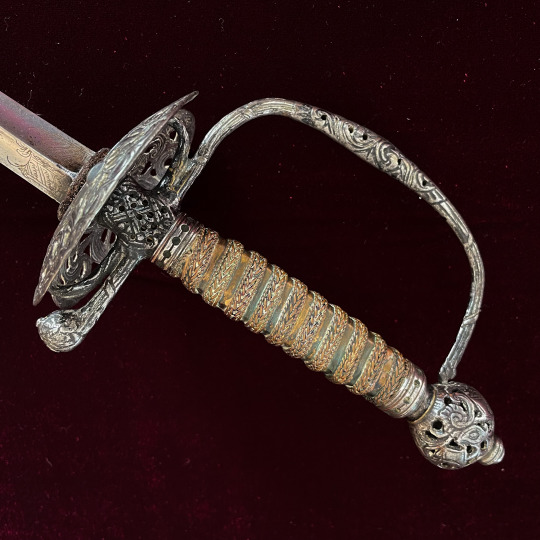
Late 18th Century European smallsword with a chased and pierced steel hilt. The guard is a symmetrical in the 'Pas d'ane' style and decorated with military trophies indicating that this might have belonged to a military officer. The grip is square and bound with alternating copper ribbon and twisted wire. Originally this would most likely been silver plated.
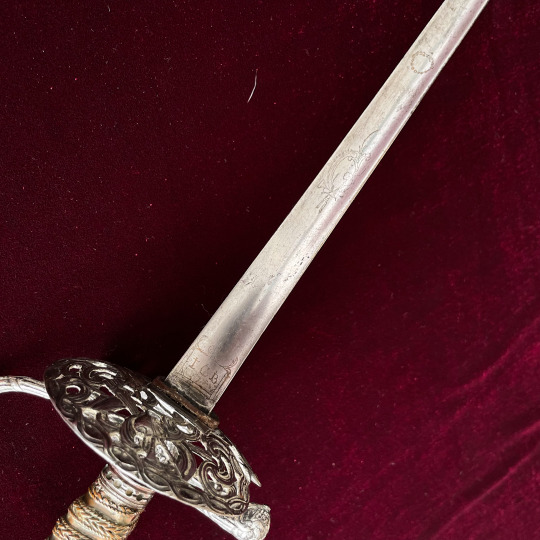
The hollow ground trefoil blade is by Johann and Clemens Boegel of Solingen and maked with their I.C.B trademark and other motifs typical of the time.
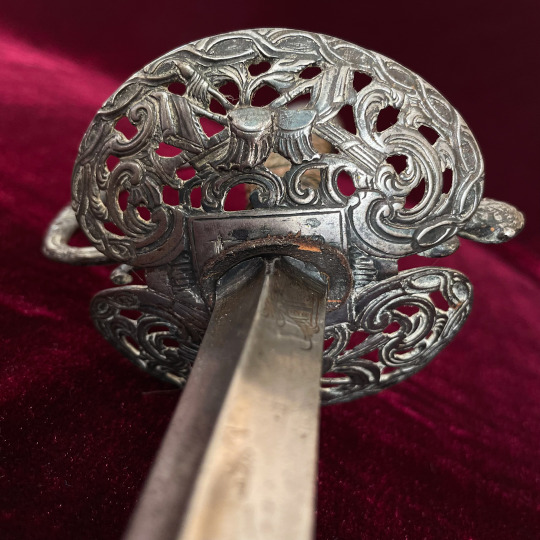
The term 'Pas d'ane' comes from French and translates as 'donkey's foot' after the shape of the donkey sole. Commentators on smallswords often misidentify the small loops between the guard and the knucklebow and quillon as the 'pas d'ane' when the correct term for them is annulets.
On Western European smallswords the annulets are a decorative hang over from earlier fencing styles when they were larger to allow the fencers' finger over the crossguard.
251 notes
·
View notes
Text

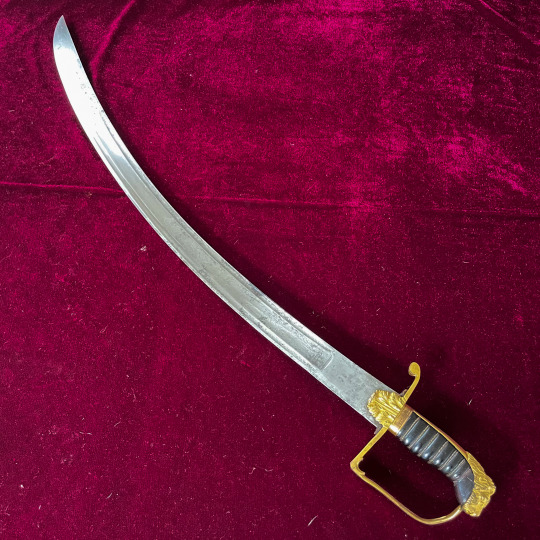
Georgian Light Cavalry Style Officers' Sabre by S. Brunn
This sword is another one of those obscure British Officer swords of the Georgian era that draw inspiration from the light cavalry style sabres. The scabbard locket is marked "BRUNN Sword Cutler to the Prince Regent 56 Caring Cross London" which dates the swords to between 1811 and 1820.
From 1800 to 1811 Brunn advertised himself with "By Appointment to H.R.H The Prince of Wales" which then changed to "The Prince Regent" from 1811 to 1820. He also changed address once, situated at 55 Caring Cross from 1799 - 1804, while his address was listed in 1805 as 56 Caring Cross.
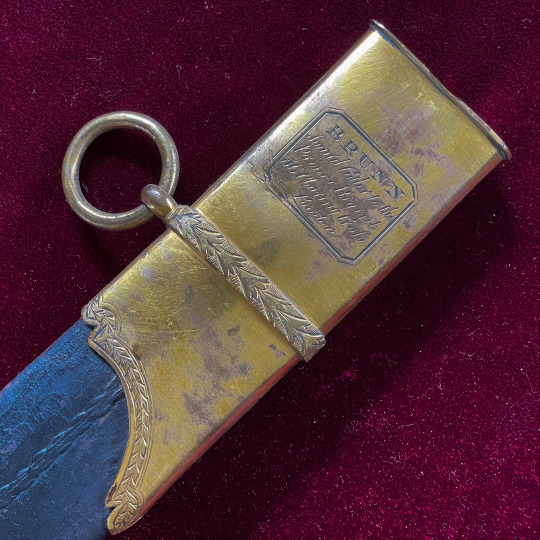
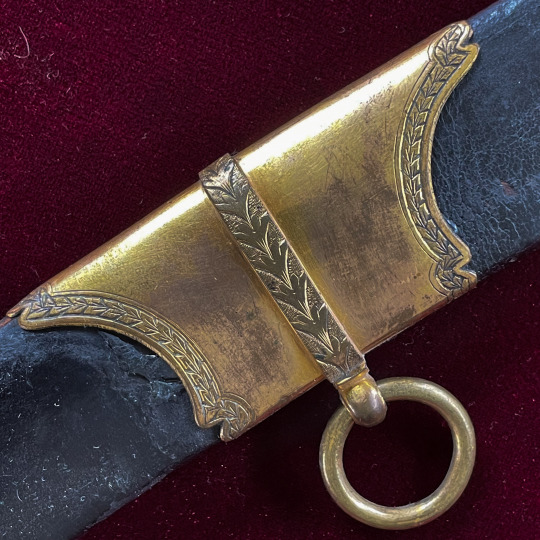

Samuel Brunn was one of the premier sword cutlers of the Georgian era, which is reflected in the workmanship of this sword. Unfortunately there are no unique identifiers on the sword to give us a clue as to who first owned it, so we can only speculate that it was a well to do gentleman that wished to retain a solid blade.
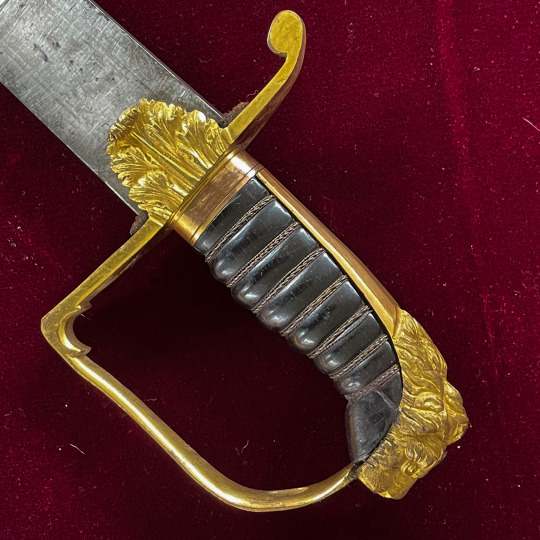
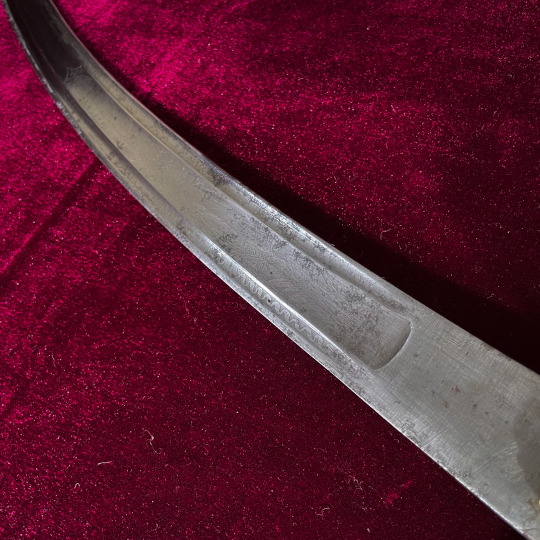
The half lions head pommel is fairly typical of infantry officers swords of the time, but again there is evidence that this style was used by Naval, Artillery and some Cavalry officers as well. And the short blade length would certainly have been more practical on a ships' deck or behind an artillery battery than on a horse. One other clue is the absence of a frog stud on the scabbard locket, meaning that this sword was only ever intended to be carried on a belt (as opposed to a sword baldric).
But as always, everything is pure speculation, there were just too many variations and quasi-military roles where it was the practice to wear a sword as part of the dress code to ever know for sure.
Stats: Overall Length - 810 mm Blade Length - 695 mm Curve - 57 mm Point of Balance - 130 mm Grip Length - 106 mm Inside Grip Length - 90 mm Weight - 720 grams
#Sabre#swords#British Army#Georgian Era#Napoleonic era#military antiques#antiques#antique weapons#Militia#Samuel Brunn
95 notes
·
View notes
Text
British Lancer Officer's Full Dress Sword
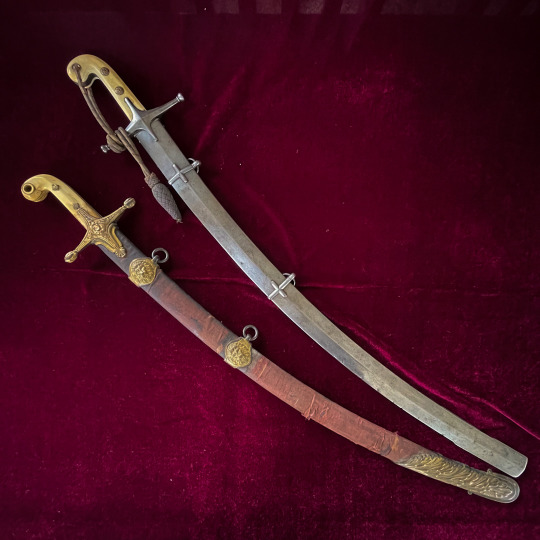

"On 25th April 1822, the first Dress Regulations for the Army (Regulations for the Dress of General, Staff, and Regimental Officers) were published by the Adjutant-General's Office and practice of carrying a 'mameluke-hilted' sword by officers of the cavalry received official sanction for the first time: the three existing lancer regiments - the 9th, 12th and 16th Lancers - were prescribed a 'mameluke-hilted' sword with a plain metal scabbard for dress wear and a velvet-covered scabbard for full dress." - The British Cavalry Sword 1788 - 1912 by Richard Dellar, Pg 111

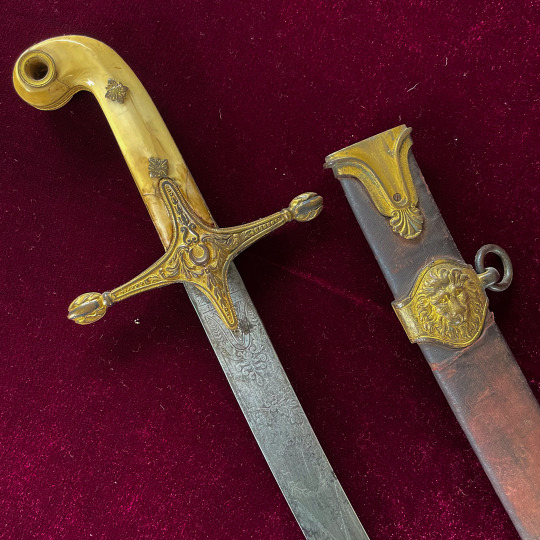

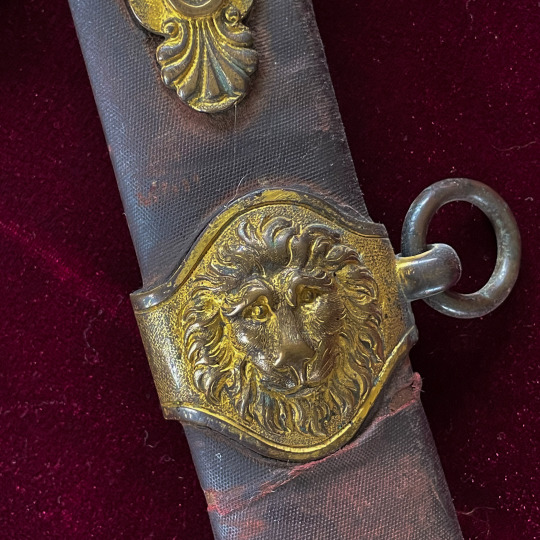

#Sabre#sword#Mameluke sabre#British Army#Cavalry#Dress swords#Antiques#Military Antiques#Lancers#Light Cavalry#Georgian Era
91 notes
·
View notes